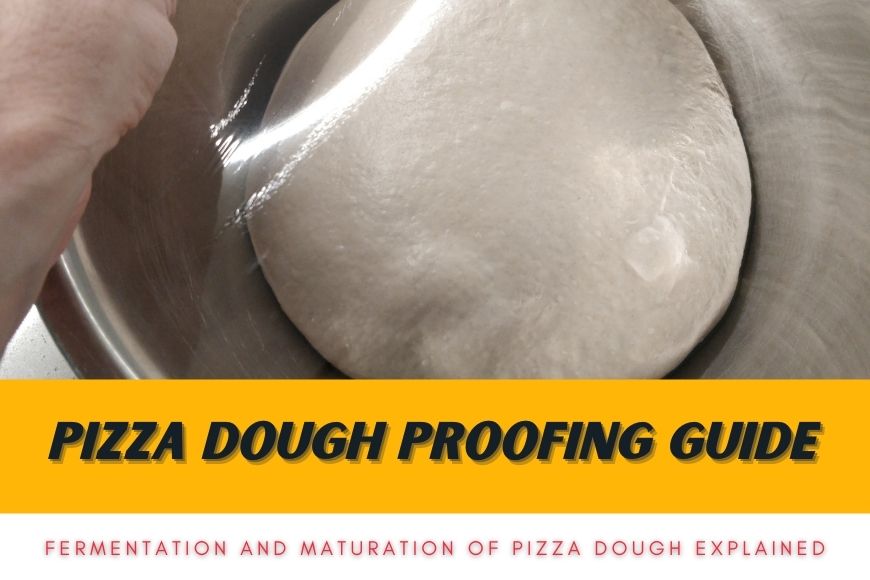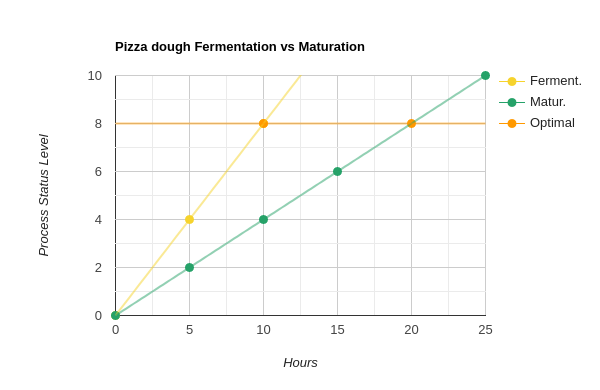
Pizza Dough Proofing Guide – Fermentation Explained
Last updated on November 27th, 2023 at 05:44 pm
Do we really need to have a 24, 48 or 72 hours dough fermentation? What happens when we rise the pizza dough for so long? In this Pizza Dough Proofing Guide we will discover more about pizza dough fermentation. Not only. We will also introduce the underestimated concept of pizza dough maturation.
In a lot of Pizza recipes you are asked to have the dough rising for 24 or 48 hours. In some cases you can even read to push the fermentation up to 72 hours, if not more. But we should ask to ourselves why we need to rise the pizza dough for so long and if we really need so. I also think that we should try to understand what caused this trend of very long dough fermentation and if that makes sense at all.
In this article we are going to cover the following topics:
- Pizza Dough Fermentation VS Maturation
- The Usage of Fridge: Pizza Dough Cold Fermentation
- What Flour to Buy to Sustain the Fermentation Time
- The Trend of Long Fermentation: “Scam” of the More Digestible Pizza?
- How Long Pizza Dough Needs to Rise
- Pizza Dough Proofing Guide Summary and Conclusion
At the end of this Pizza Dough Proofing Guide you will know how much truth there is behind long fermentation pizza recipes trend. Also you will be able to decide for yourself if and when you want to push your pizza dough rising to its limits and what flour to use to do so.
Pizza Dough Fermentation VS Maturation
We often read and hear about fermentation process time. Fermentation means rising. In other words we are referring to the activity of the yeast. Of course I am simplifying a lot the concept. Actually I am doing it on purpose. I do not think you need to care too much about the detailed chemical process that happens during this phase. The fermentation is a critical step of the pizza making process but is enough to know it at a very high level.
Fermentation and maturation are different processes happening at a completely different speed
But there is another chemical process that happens in the dough: the maturation. Fermentation and maturation process are very often happening at the same time. But not only they are different, they also happen at a completely different speed. So let’s start with a definition of the two. We will then move to their aspects.
What is Pizza Dough Fermentation and What is Pizza Dough Maturation
Pizza dough fermentation or pizza dough rising is the chemical process where the yeast eats the sugar in the dough and converts it to CO2. Of course this definition is over simplifying what is really happening, but you get the idea.
On the other end pizza dough maturation is the chemical process where complex sugars are reduced to less complex ones. Some people are associating the dough maturation process with the final digestibility of the Pizza. Specifically, the theory says that letting the proteins to reduce complex sugars into simpler ones anticipate what the human digesting system is doing when we eat.
I still have some doubts about the fact that dough maturation process is entirely responsible for how much the pizza is easy to digest. But I am absolutely confident when I say that maturation process makes the Pizza tasting differently!
The big practical difference: speed of fermentation and maturation
If it is true that the two processes are different from a chemical perspective, we need to also add they are also different when it comes to the time they require to come to a conclusion.
More in details, we can say that the pizza dough maturation process is slower than the one of fermentation. And when I say slower I mean a lot slower! They are actually kind of racing each others. Think about it as a race between a turtle (maturation) and a rabbit (fermentation). Let me try to share a graph to give you the idea:

In the picture above you find in yellow the line that represents the pizza dough rising time. The green line represents the pizza dough maturation time. As you can notice, they not only grow at a different speed, but they also never cross each others!
What the above means is that we can easily have a product that is properly fermented but not yet mature. While normally a mature product is most of the time over fermented.
Pizza Dough Proofing Guide Tip
What we are going to achieve with this guide is to understand how we can fix the issue above. Specifically how we can try to have the line of the maturation crossing the one of the fermentation. Or if not crossing at least to travel very close.
And there is only one way to achieve that: using the pizza dough cold fermentation!
The Usage of Fridge: Pizza Dough Cold Fermentation
As we often do in this website we are going to talk about temperatures. Those are critical in cooking. And pizza is not different.
In the graph above I have considered that both fermentation and maturation of the pizza dough are happening at room temperature. Of course this is just for your reference, so don’t take for granted that the indicated hours are effectively valid for every recipe.
Now, we know that the pizza dough rising is happening at a faster speed than dough maturation and that we want to find a way to have the two processes crossing each others. How can we achieve that? We can think about speeding up the dough maturation. Or we can slowdown the fermentation. The first is not something that we can really control. So we we have no other option than slowing down time to rise pizza.
In order to achieve our goal we need to add one more piece of information to our puzzle: what is the ideal temperature for the yeast to work?
Yeast activity and temperature
In this article I am assuming that we are talking about a standard yeast. I will not refer to sourdough or any other indirect methods. So we are talking about the simplest pizza dough to make at home.
Yeast has a favorite temperature to work
Yeast has a favorite temperature to work. If we go too much over it we will kill yeast. But what happens if we reduce the temperature in which the yeast is doing its job? Well, we are simply going to slow down the activity of the yeast.
In the table below I will show you some details about the yeast activities related to the temperature. Let me anticipate right now that you can notice how there is a favorite temperature for the yeast to work. But at the same time there is a temperature where the yeast slows almost completely even though is still alive.
YeastActivity
| Temperature (°C) | Activity |
| 3-4 | Almost no activity |
| 5-18 | Low activity |
| 26-35 | Ideal range |
| >60 | Yeast death |
As you can see we can definitely play with temperatures and use longer rising/fermentation time to reach a decent level of maturation.
Some books are mentioning to store the dough at 3-4 Celsius degrees so that we almost stop the fermentation while permitting the maturation process to continue. I personally found with the experience that it is much better to us a bit higher temperature. I personally store my dough after kneading for its Puntata at 6 Celsius degrees.
Ideal Dough Maturation Time
Until now we understood the basic concepts of maturation and fermentation. Moreover we now know that we can slow down the fermentation reducing the temperature of the environment where the dough will indeed ferment.
However we still need to answer to a one more critical question. How much a pizza dough needs to wait before we can consider it mature?
There is not an easy and unique answer to this question. According to the books I read you need between 24 and 48 hours, also depending on the flour you use. In my experience I never have the dough resting more than 48 hours. I can say that 90/95% of recipes I use and share on this website have around 24 hours of total dough maturation and fermentation.
What Flour to Buy to Sustain Fermentation Time
When we talk about fermentation and maturation we can’t really escape from considering also what flour we are using.
If it is true that for a proper pizza dough maturation we need to have the dough resting for 24 hours, then we need to make sure that the flour has enough “food” to sustain processes for such amount of time. This is particularly important when it comes to pizza proofing process. Having the yeast working for long time, even if at a slow pace, means we need to have enough proteins in the flour.
The rule that we should follow is that the more we have the dough resting, the more we want to have high amount of proteins in the flour and vice-versa. If we want to be more precise, instead of looking at amount of proteins, we need to refer to the W value of the flour, whenever available.
For pizza dough you should never use a flour with low W value. And if you want to keep the pizza dough in fridge for many hours you want to increase it.
In my experience I found that for a 24 hours fermentation/maturation it is good to use a flour with at least 280W. I personally tend to use even stronger flours for pizza in pan or sheet tray (more than 300W). In some recipes I even prefer to use much stronger flours, like 340/380W. In this last case I can push the fermentation process easily to 48 hours.
The trend of Long Fermentation: “Scam” of More Digestible Pizza?
In the last months, if not years, we find a lot of restaurants and pizzerias claiming that they sell a very digestible pizza. To support what they promise to customers in terms of pizza digestion they tell that their pizza dough has a very long fermentation. Generally they talk about at least 48 hours fermentation. In some cases I even found advertisements for 72 hours pizza dough resting.
But is there a real link between digestion and long fermentation or maturation?
Is there a real link between digestion and long fermentation or maturation?
Well, somebody tried to explain that yes, there is a connection. As I was saying before, the claim is that the maturation process anticipates what our digestion system is asked to do: decompose complex parts into less complex ones. But if you ask me, there is not a proven medical study that supports this theory. Or at least I could not find any on the official sources available to me.
So, I consider that this is more a good commercial trick than a real proven fact.
On the contrary I really feel a difference in the taste of the pizza when using longer maturation. That is something that you can prove empirically, without needing a study. Just try the difference of the same recipe using the cold fermentation, making the process of maturation and fermentation working for longer time. There is definitely a difference!
How Long Pizza Dough Needs to Rise
This is a very complicated question to ask. Once again, there is not a specific answer. The truth is that it depends.
Some pizza types taste much better or build the right structure using very long maturation. Some other pizza types can be created in much less hours. So to give you a couple of examples:
Pizza in sheet tray, high hydration, like the one I am showing in this video, prefers to have at least 24 hours of maturation. Also Neapolitan style pizza likes to have a 24 hours maturation. However, in both cases, you can still get an absolutely good result reducing the time to few hours. Let’s say 8/10 hours.
Another good example is Focaccia. This one does not generally requires long maturation. In few hours you can get an excellent focaccia!
My suggestion, however, is to try to use the pizza dough cold fermentation technique and push the dough resting for 24 hours. The reason is not only related to the taste, but also to how much easier is to manage the pizza preparation. You can calibrate much better when to make the dough and when to shape it to cook!
Pizza Dough Proofing Guide Summary and Conclusion
It is now time to come to a summary and conclusion of this Pizza Dough Proofing Guide. What we discussed in this article is pretty complex. But still it is taken from a very high level perspective, so that we don’t over-complicate the pleasure of making pizza at home.
To recap we observed that:
- Pizza dough maturation is a different chemical process than pizza dough fermentation (or proofing or rising)
- the dough maturation is a much slower process than the one of fermentation
- to have a pizza dough that is mature and properly proofed we can have the dough resting in fridge during the first fermentation
- ideally you want to have the cold fermentation happening at a temperature that is not lower than 6 Celsius degrees
- for long fermentation times you need a strong flour, with a W value not lower than 260/280
- pizza dough long fermentation does not necessarily mean that it will be more digestible.




8 Comments
Thanks for sharing your knowledge. I still have a question with regards the 24h proofing. What is the temperature I should set the fridge for a 24 hours proofing? Thanks
Hello Claudio, thanks for your comment. There isn’t a catch-all rule. Because it depends on various factors like hydration and amount of yeast used in the recipe. In general, besides considering the 24 hours per se, I prefer to let the dough resting at cold between 5 and 6 Celsius. Sometimes in professional environment you need to use the standard 4Celsius. But here the “problem” is that the fermentation is going to stop completely. So, whenever you can, I would recommend to balance your recipe to leverage 5-6 Celsius degrees.
Thanks Stefano for your answer. I normally go for 60% hydration and 1.5g of dry yeast + 5g of honey for every kg of flour which I leave for 2 hours in Puntata before making the panetti and putting in the fridge for 24 hours. I then take them out of the fridge 4 hours before stretching the pizzas. Any recommendations you have to improve the process I am currently following? Thanks for your help and, by the way, your website is really good because it’s got lots of technical information essential for those who want to really understand about the science of making pizzas.
Hi Claudio, thanks for your feedback on my website. I am glad you got exactly what is my goal: share technical knowledge rather than just a bunch of recipes. BTW, 1.5gr of dry yeast on a kg of flour looks a good amount for a 24 hours in fridge! The only recommendation is that I would not use honey, I don’t think you need it 🙂
I’ve just started following you on Instagram. I was watching the video you talk about the reasoning behind using olive oil to make the dough. All good stuff. How much olive oil do you recommend? I have wooden oven and I bake the pizzas at 390°C in about a minute.
Following on my comments on Instagram, I recommend to avoid oil. Especially when you bake at high temperature and you eat pizza immeditaly 😉